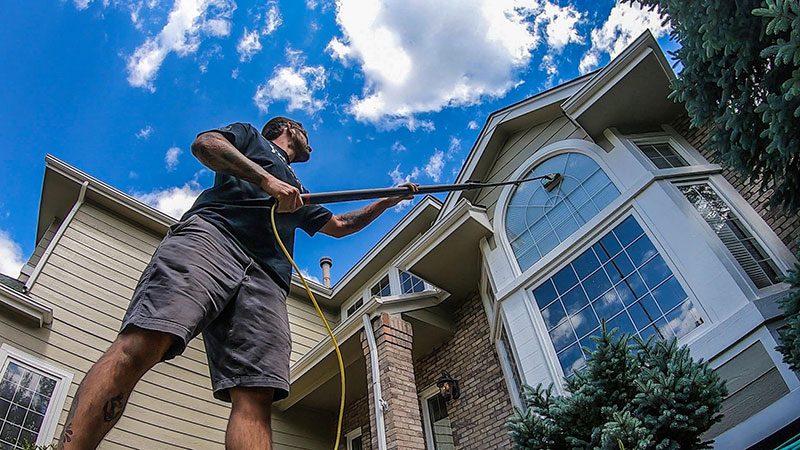Windows are one of the most defining features of any building’s architecture. They shape the way natural light flows into a space and impact how the world sees the structure from the outside. Over time, however, external factors such as dirt, dust, rain, pollen, bird droppings, and pollution can leave windows looking cloudy, streaked, or completely opaque. This makes exterior window cleaning not just an optional chore—but an essential part of maintaining your property’s appearance and value.
In this comprehensive guide, we’ll explore the benefits of regular exterior glass maintenance, the tools and techniques professionals use, common mistakes to avoid, and how to maintain clean windows in between deep cleanings. Whether you’re a homeowner trying to boost curb appeal or a property manager aiming to present a clean and professional exterior, this guide will help you achieve crystal-clear results from the outside in.
Why Exterior Window Cleaning Shouldn’t Be Ignored
It’s easy to focus on indoor maintenance and forget that the outside of your windows takes the biggest beating from the elements. Unlike interior glass, exterior windows are constantly exposed to dust storms, rain, hard water deposits, insect residue, sap, and pollution.
Here are just a few reasons why exterior window cleaning deserves your attention:
1. Protects Window Materials
Environmental contaminants, when left to build up, can erode window surfaces. Hard water stains, bird droppings, and acidic pollutants can weaken glass and corrode metal frames over time. Regular cleaning preserves the structural integrity of your windows.
2. Boosts Curb Appeal
Whether you’re welcoming guests, tenants, or clients, clean exterior windows instantly enhance the look of a property. Dirty windows are among the first things people notice and can create a negative impression—even if the rest of the building is spotless.
3. Maximizes Natural Light
A layer of dirt can reduce the transparency of glass, dimming natural light that enters your home or office. Clean windows enhance brightness indoors, creating a more vibrant, healthy, and uplifting space.
4. Saves Money in the Long Run
Preventive maintenance is always more cost-effective than repair or replacement. Regularly cleaned windows are less likely to suffer from permanent etching or degradation, which can require expensive fixes or full replacements.
Understanding the Unique Challenges of Exterior Cleaning
Unlike interior windows, cleaning external glass comes with added complexity. Safety concerns, height access, weather variables, and tougher grime make the process more labor-intensive and demanding.
Weather Impact
Exterior glass is exposed to UV radiation, rain, wind, and temperature fluctuations—all of which affect how dirt adheres to the surface. For instance, after a heavy rain, mineral deposits can be left behind if the water isn’t pure.
Safety Concerns
Cleaning windows on upper floors or from awkward angles can pose significant safety risks. Proper tools like extension poles or ladders—and in many cases, professional assistance—are essential to avoid injury.
Stubborn Residue
External windows may have sap from nearby trees, oxidization from metal parts, insect residue, or paint overspray. These materials are not only tough to clean but can also scratch glass if removed improperly.
Tools and Equipment You’ll Need
Achieving a streak-free, sparkling result depends heavily on having the right tools for the job. For efficient exterior window cleaning, you’ll want to invest in or prepare the following:
- Extension Pole: For reaching high or awkward windows safely from the ground.
- Squeegee with Replaceable Rubber Blade: Ideal for pulling away water and cleaning solution without leaving streaks.
- Microfiber Cloths: Soft and absorbent materials for drying and buffing.
- Bucket: To hold your cleaning solution.
- Soft-Bristled Brush: Effective for scrubbing stubborn dirt or debris.
- Garden Hose with Spray Nozzle: For rinsing windows and surrounding areas.
- Window Cleaning Solution: Commercial products or DIY mixes (e.g., vinegar and water) work well, depending on the level of grime.
In more advanced or commercial applications, tools like water-fed poles with deionized water systems are used. These systems leave windows spotless by eliminating minerals that cause water spots.
How to Perform Exterior Window Cleaning Step-by-Step
A systematic approach will yield the best results. Follow this process for professional-quality cleaning.
Step 1: Remove Loose Dirt and Debris
Begin by rinsing your windows with a hose or bucket of clean water to dislodge loose dirt, cobwebs, or pollen. This prevents debris from scratching the glass during scrubbing.
Step 2: Apply Your Cleaning Solution
Use a sponge, soft cloth, or cleaning wand to apply your solution liberally across the entire glass surface. Allow the cleaner to sit for a few moments to break down grime, but don’t let it dry before rinsing or squeegeeing.
Step 3: Scrub the Surface
Gently scrub with a soft-bristled brush or cloth, focusing on the edges and areas where residue tends to accumulate—like corners, window sills, and under overhangs.
Step 4: Rinse Thoroughly
Using a garden hose or a bucket of clean water, rinse away the cleaning solution and loosened dirt. If you’re using deionized water, there’s often no need to dry the window, as it won’t leave mineral spots.
Step 5: Squeegee Dry
Working from top to bottom, pull the squeegee across the window in straight lines. Wipe the blade with a lint-free cloth after each pass to prevent streaks.
Step 6: Final Touches
Use a dry microfiber cloth to wipe up any remaining drips or smudges along the edges and sills. Buff the glass for a final shine.
Mistakes to Avoid During Exterior Window Cleaning
Even a few small errors can ruin your efforts. Avoid these common pitfalls:
- Cleaning on Sunny Days: The sun can dry your cleaning solution too fast, leaving behind streaks.
- Using Dirty Water or Tools: Always work with clean supplies. Reusing dirty cloths or water only moves grime around.
- Neglecting Frames and Sills: Cleaning the glass without wiping down the surrounding structures creates a half-done appearance and can promote rot or mold.
- Skipping Safety Measures: Never lean out of windows or climb unstable surfaces without proper support.
- Using the Wrong Chemicals: Avoid ammonia-based cleaners on treated or tinted glass, as they can cause damage.
Maintaining Your Windows Between Cleanings
Keeping windows clean over the long term doesn’t always mean deep scrubbing every month. With the right strategies, you can extend the time between major cleanings while maintaining a clear view.
- Trim Surrounding Trees: This reduces sap and leaf buildup on your windows.
- Install Window Screens: Screens can trap debris and insects before they hit the glass.
- Use Rain Repellents: Certain glass coatings repel water and reduce the appearance of streaks.
- Regularly Dust Sills and Frames: This prevents buildup from transferring to the glass during rain or wind.
When to Consider Professional Help
While many homeowners and businesses handle their own exterior window cleaning, there are scenarios when hiring a professional is both safer and more efficient:
- Multi-story Buildings: Cleaning windows above ground level introduces serious safety concerns.
- Persistent Stains: If your windows have etching, calcium deposits, or long-term pollution stains, professionals have access to specialized solvents and equipment.
- Time Constraints: Outsourcing saves time and guarantees a polished result.
When choosing a service provider, look for experience, customer reviews, and insurance coverage. Professionals often bring efficiency, safety, and superior results that DIY methods can’t always replicate.
How Often Should You Clean Exterior Windows?
The ideal frequency depends on your environment:
- Every 3–4 months in urban areas or locations with high pollution.
- Twice a year in rural or less trafficked areas.
- Seasonally if you live in regions with distinct weather patterns (e.g., spring pollen or autumn leaf fall).
Regular scheduling not only maintains appearances but also prevents long-term damage from contaminants and exposure.
Final Thoughts
Windows are the eyes of any building, and keeping them clean—especially from the outside—is a powerful way to maintain the overall appeal and health of your property. Regular exterior window cleaning enhances curb appeal, improves light quality indoors, and helps preserve the long-term integrity of your window materials.
By investing time in proper cleaning techniques and using the right tools, or by hiring skilled professionals when needed, you can enjoy clear, spotless windows year-round. Whether you’re maintaining a home, office, or commercial building, clear windows reflect the care and attention you give to your space.
So don’t overlook the outside—because clean, gleaming windows begin where the world sees them first.





























